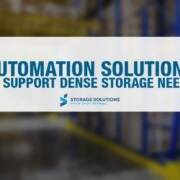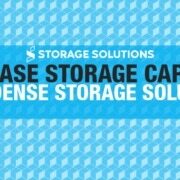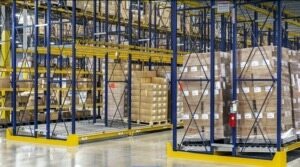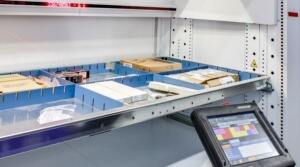Whether it is time to reconfigure your operations within a warehouse or design a new warehouse, a common goal in the design team is to get the most capacity out of each square foot of the facility. Wasted space – both horizontally and vertically – means lost potential revenue because, by default, you are not able to store as much as you would with dense storage solutions.
Traditionally, facility design engineers would take standard pallet racking – a lot of it – and find ways to slot inventory appropriately to optimize storage. They would look at opportunities to reduce unused space while factoring in order frequency and a few other variables. Occasionally, dense storage options like pushback racking and carton flow get included as well. Others would fill their facility with a sprawl of shelving or a combination of all the above.
But what happens when the supply chain changes? What happens when consumer expectations change? What happens when you need to incorporate more safety stock or turn around orders faster?
When considering the design (or redesign) of a facility, there are great alternatives to increase storage capacity within your footprint by introducing a combination of dense storage and automation solutions at varying degrees.
By introducing automation, warehouses can maximize space utilization with good throughput in the face of labor challenges. Especially as e-commerce continues to rise while traditional full-pallet shipping falls, warehouses are looking to adapt by doing more work with less labor.
So what options are out there for those making these decisions? Let’s take a look.
Semi-Automated Deep Lane Storage Solutions
For those who store products on pallets with large quantities of pallets on hand for specific SKUs, semi-automated deep lane storage solutions – commonly referred to as pallet runners, shuttles, or moles – can add capacity to warehouses by using technology to load, store, and unload pallets. A cart (or runner/shuttle/mole) transports a pallet along a lane with these storage systems and empties it into the first available storage position. These systems are dense in that they can store 12-40 pallets per lane, depending on the configuration. They are adaptable, capable of running continuously and help reduce damage to products and racking structures by staying within their respective lanes.
Example: AutoMHA’s Pallet Runner
Automated Storage & Retrieval Systems (AS/RS) for Unit Load Handling
Cart-Based Solutions
In some ways, like the semi-automated deep lane storage, there are cart-based unit load AS/RS pallet handling solutions that can move bi-directionally to store and retrieve pallets and products automatically. These shuttles are highly reliable, easy to install, and adapted and scaled when growth calls for additional throughput needs. Cart-based systems can often provide higher throughput & better storage density than traditional crane-based AS/RS systems.
Examples: Optimus Automation’s Robotic Pallet Shuttles, Advanced Storage’s Rover
Crane-Based Solutions
Crane-based AS/RS technology has been around for some time in warehouses. These cranes can store and retrieve pallets within a storage system that maximizes vertical storage density at high speed. These systems offer improved efficiency, simple operation, and an easy maintenance plan.
Example: Daifuku’s Stacker Cranes
Cart-Crane Combination Solutions
Crane-based AS/RS systems that also incorporate carts provide the cost benefits of crane solutions with the added storage density that can be achieved using carts. These systems can accommodate both deeper lane storage and single or double-deep storage if there is a mix of typical on-hand quantities per SKU.
Example: AutoMHA’s AutosatMover
Dense Storage Solutions for Less-Than-Pallet, Unit Handling Environments
Mini-Load AS/RS Shuttles
Mini-load AS/RS shuttles are excellent in environments in which high throughput rates are required for picking eaches or cases within a distribution center. They significantly increase the storage density, accuracy, and speed with which products are stored and picked, and adapted to different building configurations. As a solution for getting products as quickly as possible from storage to staging, these systems can also serve as a short-term buffer system or act as manufacturing support for production operations.
Example: Dematic’s MiniShuttle
Vertical Lift Machines (VLMs)
VLMs offer warehouses a goods-to-man picking solution, ideal for storage and picking of small-cube and slower-moving items. They are great because they maximize floor space – 5,000 square feet of traditional storage can fit into about 150 square feet because of the machine’s height. VLMs offer high pick rates and can store a large cubic volume of a product. They are typically paired with a pick-to-light batching table and utilize software to allow for picking multiple orders simultaneously.
Example: Kardex’s Vertical Lift Modules
Vertical and Horizontal Carousels
As a high-density storage solution with a small footprint, vertical carousels are ideal for storing small parts. Products are organized by SKU in individualized boxes or totes that are secured to a series of shelves that rotate like a Ferris wheel. They revolve around a track and are accessible to a picker through a pick window. Horizontal carousels rotate similar to a dry cleaning rack, which allows your worker to stay in one area while the products turn to them. This action reduces travel distance and picking time, with multi-window and multi-level configurations available.
Example: Kardex-Remstar’s Vertical Carousels and Horizontal Carousels
Other Robotics-Based Dense Storage Automation Solutions
Ultra-High Density Goods-to-Person Storage and Buffering System
If you are in the market to bring maximum flexibility, scalability, and storage to your operations, ultra-high-density storage and buffering system will get you there. This system brings optimal storage for warehouses with many thousands of SKUs that need to facilitate very small order sizes, particularly in a small footprint warehouse. Ideal for e-commerce, these systems can facilitate multiple simultaneous orders with 3-dimensional automated picking that brings with it highly accurate order picking within an ultra-dense storage grid.
Example: Dematic’s AutoStore
3-Dimensional Automated Order Picking Systems
Automated dense storage solutions can also come in the form of a 3-axis storage system that uses autonomous mobile robots to facilitate storing and picking products. With these goods-to-person systems, an operator will give the AMR an order, which will then travel along a floor path to a specific location. From there, a shelf-climbing robot will lift the AMR to a particular location where it will select the product and deliver it back to the operator for batching. This system saves on labor and increases order speed and accuracy. They can be completely customized to meet your needs and, with quick installation, adaptable to expand as your operations grow.
Example: Exotech’s SkyPod
Which Automation Solution is Right for Your Operation?
These are just a few of the options out there, but there are a lot more that may be the right option for your operation. Sorting through and finding the right choice to meet your needs can be challenging.
We have a team of experts on hand to learn about what set of challenges you are seeing in your warehouse today and learn about what you see down the road. You may only need to invest in entry-level automation, or you may need to evaluate a fully automated facility. In reality, the answer is likely in between. Call us today and speak with a Storage Solutions expert!







